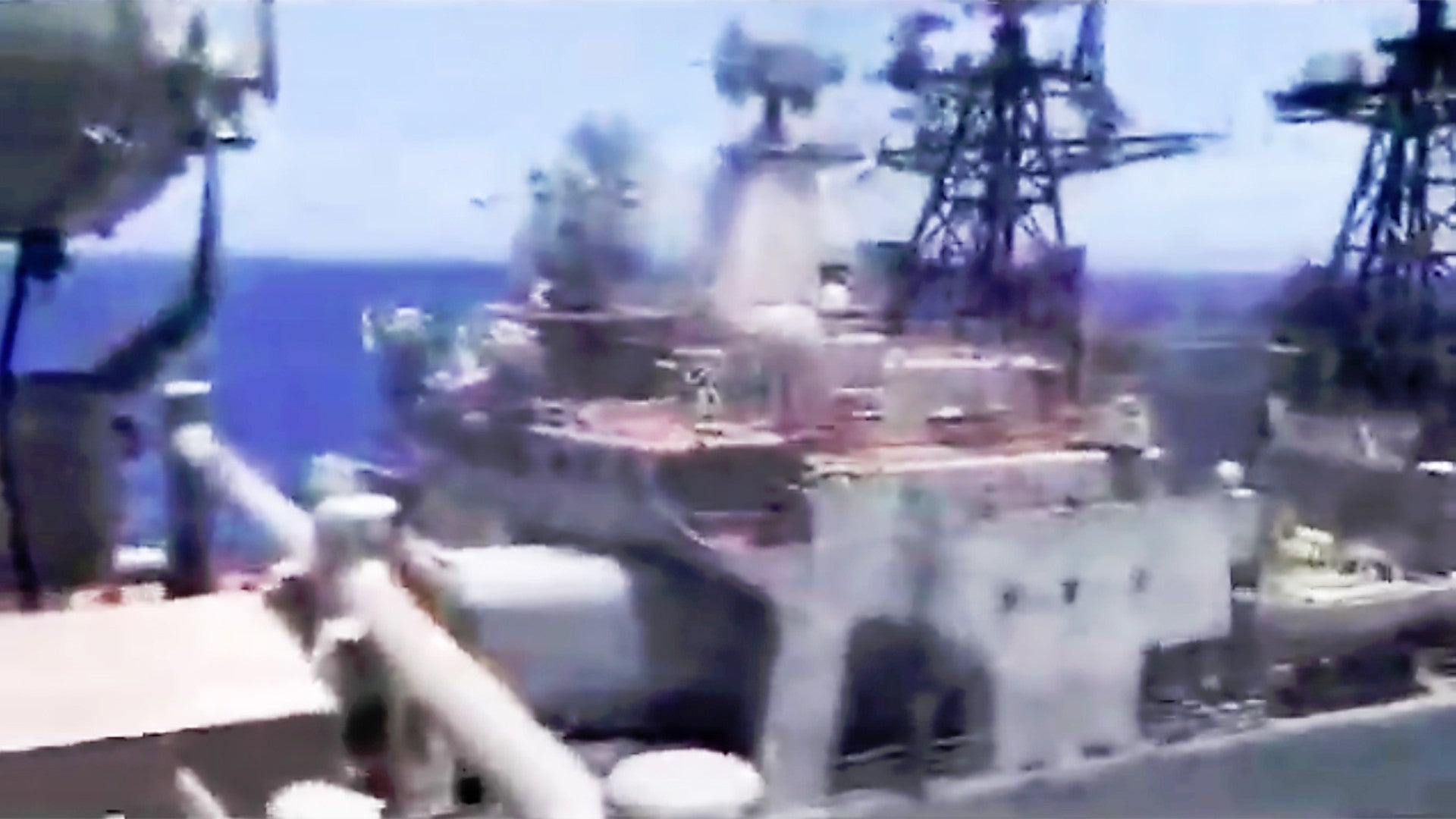The U.S. Navy’s Ticonderoga-class cruiser USS Chancellorsville and the Russian Navy’s Udaloy-class destroyer Admiral Vinogradov had a near collision in the Philippine Sea earlier today. Pictures and video show the two ships coming dangerously close to hitting each other and the Navy says Chancellorsville had to fully reverse its engines to avoid a serious accident.
“#USSChancellorsville was forced to maneuver to avoid collision when #Russian destroyer Udaloy I [Admiral Vinogradov] made an unsafe and unprofessional approach in the Phillippine Sea,” a post from the U.S. Navy’s official Twitter account read on June 7, 2019. “While recovering its helicopter #USSChancellorsville was forced to execute all engines back full to avoid collision with #Russian destroyer Udaloy I, which had come from behind and alongside within 50-100 feet in the Phillippine Sea.”
The Navy has since released two videos and two pictures of the encounter, which confirm how close the ships were until Chancellorsville was able to drop back and out of harm’s way. The pictures appear to be stills from a camera turret, which may have been on a P-8A Poseidon maritime patrol aircraft that was flying nearby or from the cruiser’s helicopter if the incident had forced it to abort its recovery.


Though 50 to 100 feet may sound like a lot, it is a worrying lack of separation between two ships displacing thousands of tons, which are slow to maneuver if something should suddenly happen. For perspective, Chancellorsville, at its greatest width, is 50 feet across and it more than 560 feet long. An actual collision between the two ships, especially if the Admiral Vinogradov had plowed into Chancellorsville‘s side, would have caused serious damage and might have resulted in fatalities.


An uncropped version of the photograph that CNN obtained above points the exact location of the incident, approximately 175 miles southwest of the Japanese Island of Okinawa. This is firmly in international waters and hundreds of miles away from any Russian territorial claims.
Russia and the United States have already exchanged accusations about who is at fault over the incident. Chancellorsville was maintaining a steady course in order to recover its Sea Hawk helicopter at the time, according to the Navy. The Admiral Vinogradov then approached from the rear and to the starboard side, or right, of the American cruiser.

The Russians, who initially claimed the incident occurred in the East China Sea, further to the northwest, said it was the Americans who cut off their destroyer and that they were in violation of the maritime “rules of the road.” It is true that these internationally-recognized rules do say that when two ships paths appear to cross, the ship to the starboard has the right of way.
“The US cruiser Chancellorsville suddenly changed its course and crossed the Admiral Vinogradov destroyer’s course some 50 meters away from the ship,” the Russian Pacific Fleet’s press service said in a statement on June 7, 2019. “In order to prevent a collision, the Admiral Vinogradov’s crew was forced to conduct an emergency maneuver.”
However, the pictures the Navy has released show Chancellorsville‘s wake as long and steady, directly contradicting the Russian version of events. There also appears to be a change in Admiral Vinogradov course and indications that it was moving at a much higher speed, perhaps to try to get in front of the American warship. The crew on the Russian ship did not appear to be taking any particular precautions for a deliberately hazardous encounter, though, with some individuals apparently sunbathing on the destroyer’s rear flight deck. Regardless, U.S. Navy Commander Clayton Doss, a spokesman for the Navy’s Seventh Fleet, which is forwarded deployed in Japan and includes the Chancellorsville, dismissed the Russian statements as “propaganda,” according to the BBC.

It is worth noting that Chancellorsville is among the most advanced ships in the Navy and is capable of performing both air and ballistic missile defense missions simultaneously, as well as engaging hostile ships and conducting strikes against land targets. The cruiser has, among other things, the latest iteration of the Aegis combat system, also known as Baseline Nine. This includes improvements to a number of important data fusion and information sharing capabilities as part of the Navy’s Cooperative Engagement Capability (CEC) and associated Naval Integrated Fire Control-Counter-Air (NIFC-CA) systems, which you can read about in more detail here.
This also isn’t the first time a Navy ship has had a dangerous encounter with another country’s warship, but the last such incident, which occurred in September 2018, involved a Chinese destroyer. The U.S. and China have long been at odds over the latter country’s sweeping territorial claims in the Pacific region, especially with regards to the South China Sea, and tensions between Washington and Beijing have been growing steadily in recent years over a host of issues, including an increasingly bitter trade war.
But it certainly isn’t the first time there have been altercations between Russian and American forces elsewhere. Notably, in June 2016, the Russian Navy also claimed that the Arleigh Burke-class destroyer USS Gravely had cut off its Neustrashimy-class frigate Yaroslav Mudry in the eastern Mediterranean Sea. It subsequently emerged that this was a misrepresentation of the events and that the Russian ship had been trying to interfere with the activities of the Truman Carrier Strike Group.
In recent years, Russian aircraft have routinely conducted unsafe maneuvers near American military planes and ships in Europe and the Middle, as well. Just days ago, the Navy said that a Russian Su-35 Flanker fighter jet had repeatedly moved dangerously close to one of its P-8A Poseidon maritime patrol planes in the Mediterranean.
We will continue to update this story as more information becomes available.
Update: 11:30am EST—
Acting Secretary of Defense Patrick Shanahan offered some comments to reporters about the incident on the steps of the Pentagon ahead of the arrival of Greek Defense Minister Evangelos Apostolakis.
“We’ll have military-to-military conversations with the Russians and of course we’ll démarche them.”
Contact the author: joe@thedrive.com
